The artists of the Renaissance knew the works of the
ancient Greek masters from Roman copies and from the few original works that
had been plundered from various sites but there was no real interest in the
originals until the German Johann Joachim Winckelmann began his
differentiations of Greek, Greco-Roman and Roman art. I’ll return to
Winckelmann another day, but it may fairly be said that he was the father of
Hellenism, the study of the Ancient Greeks.
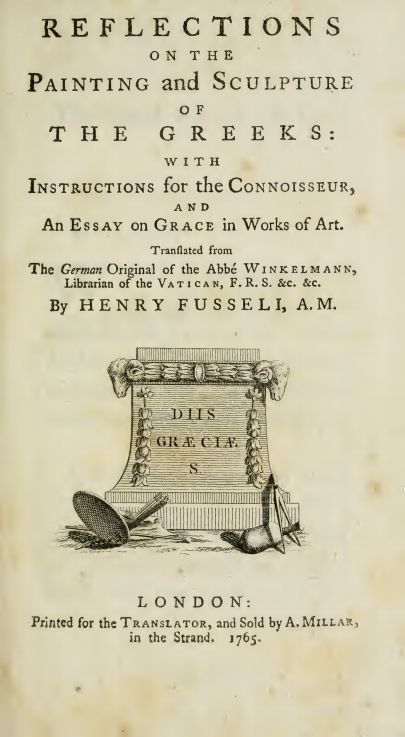 |
| Winckelmann - Reflections on the Painting and Sculpture of the Greeks - 1765 |
His masterpiece, History of
Ancient Art (1764), and other writings were crucial spurs at the time and
influenced other writers who were becoming interested in the Greeks.
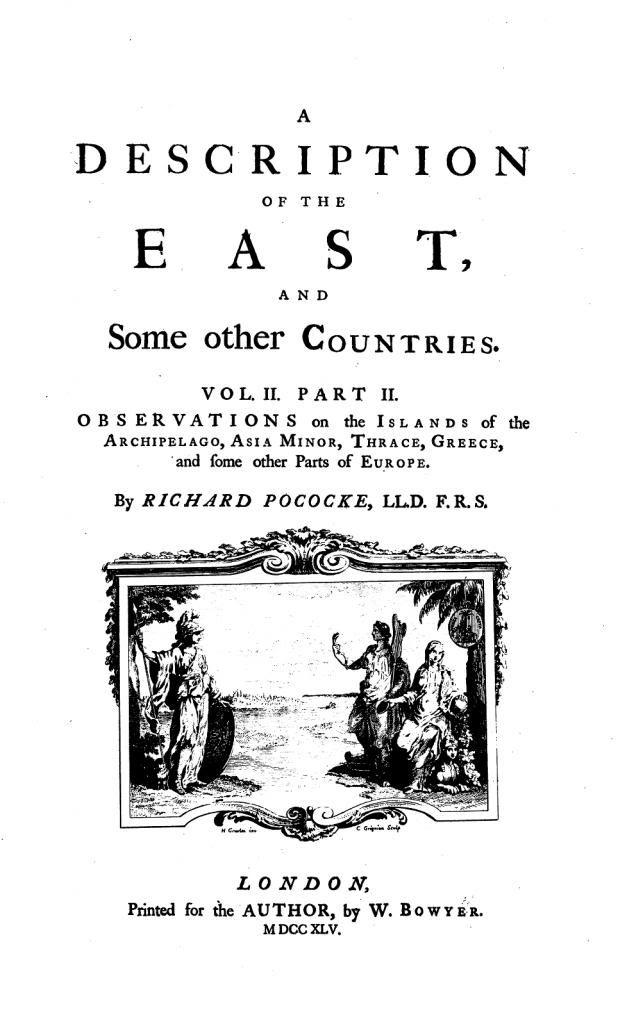 |
| Richard Pococke - A Description of the East and some other Countries - 1745 |
Richard
Pococke, an English prelate and traveller, had published an account of Ancient
Greek architecture in his A Description of the East and Some Other Countries
Vol 2 Pt 2 (1745), which are just that - descriptions - and two other Englishmen,
James Stuart and Nicholas Revett, made detailed measurements, descriptions and
drawings of ancient buildings in their The Antiquities of Athens (1762).
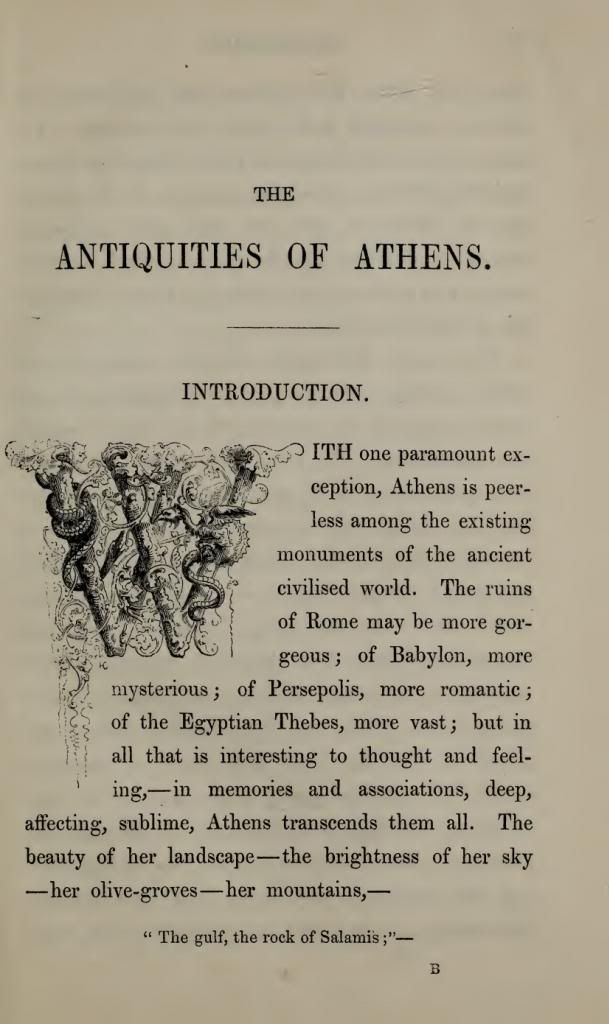 |
| Stuart and Revett - The Antiquities of Athens - 1745 |
They were members of the Society of the Dilettanti and as early as 1744 other
Dilettanti had begun to collect fragments from the Acropolis.
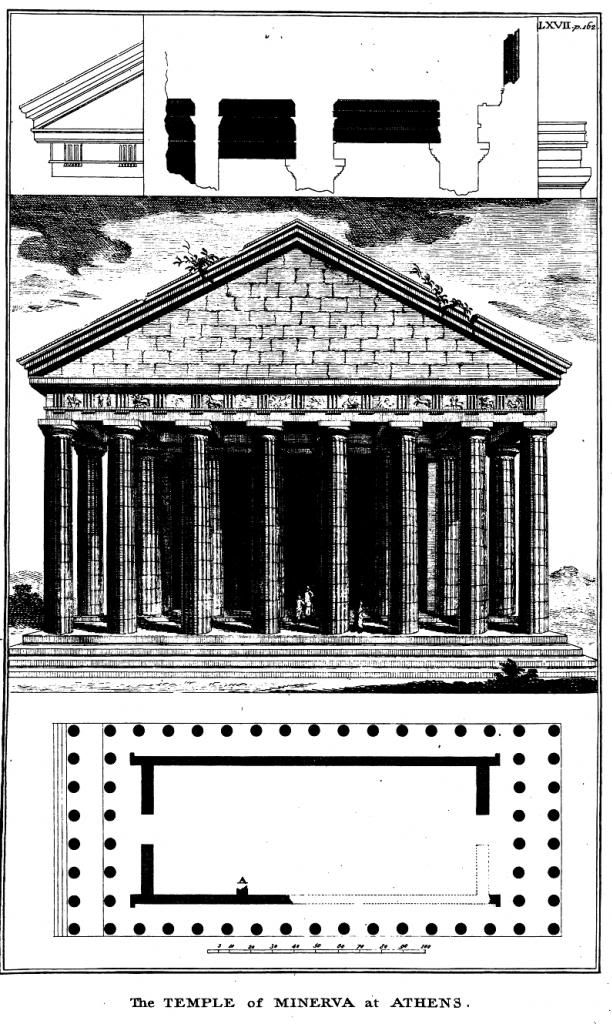 |
| The Parthenon - from Richard Pococke - A Description of the East and some other Countries - 1745 |
In 1799, a
thirty-three year old Thomas Bruce, 7th Earl of Elgin, was appointed
a special ambassador of the Great Britain to the Ottoman Empire of Selim III,
and prior to his departure to Constantinople Elgin approached several members
of the British Government with inquires as to him procuring casts and drawings
of the statuary of the Acropolis of Athens, but he was met with negative
responses or disinterestedness.
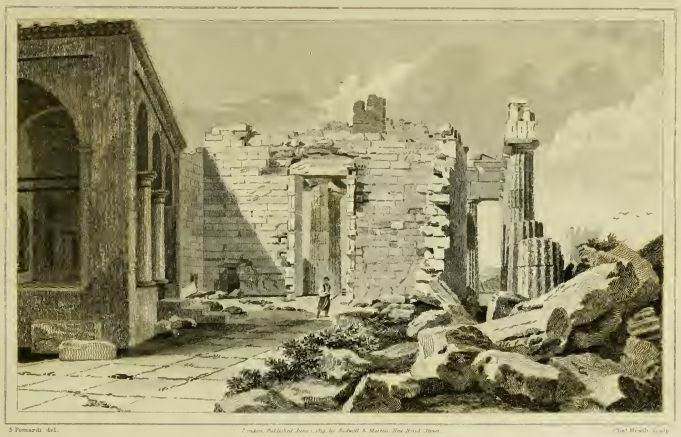 |
| Ruins of the Parthenon - E Dodwell - A Classical and Topographical Tour through Greece - 1819 |
Undeterred, Elgin enlisted two architects, a
painter, a sculptor and two moulders at his own expense, who were supervised by
Giovani Lusieri, a Neopolitan court painter, and on arrival in Constantinople he
obtained a firman (a royal mandate), which gave his team unrestricted access to
the Acropolis. When Elgin went to Athens himself, he arranged to purchase and
demolish two of the Turkish hovels built near the Parthenon. Beneath one were
many fragments of the statues from the temple but there was nothing beneath the
other; Elgin asked one of the locals why this might be and was answered by a
sardonic smile and a finger pointing to the walls – the marble statues were
being burned to provide the locals with building lime.
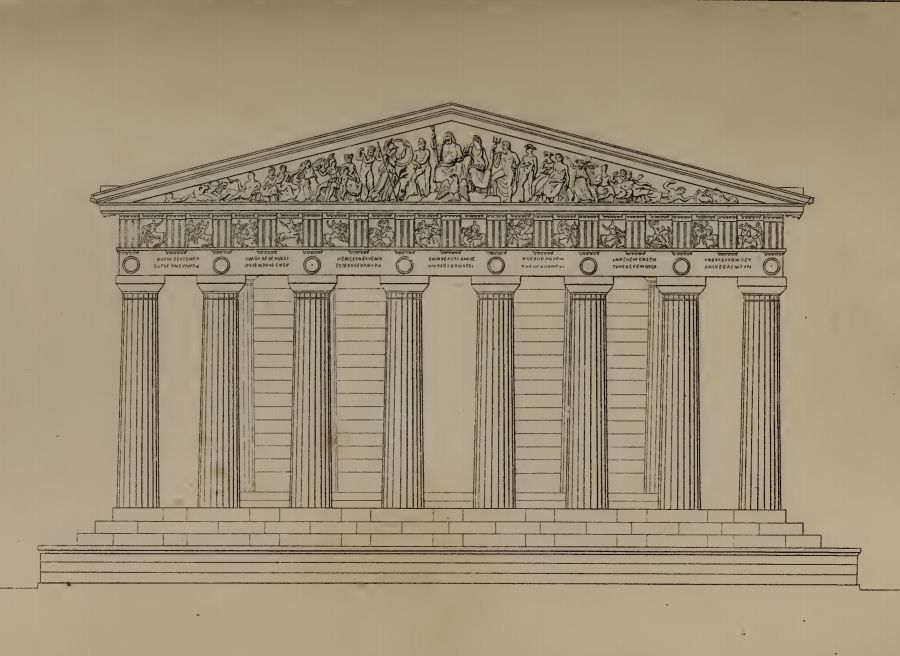 |
| The Parthenon - from Stuart and Revett - 1745 |
He compared what
remained with what Stuart and Revett had documented fifty years before and was
shocked at the amount that had been destroyed or spirited away as keepsakes by
sightseers. Concerned that they might all be lost, Elgin revised his plans to
merely document the statues and decided instead to remove them. With a sizeable
amount of bribery to local officials, Elgin applied an imaginative
interpretation to the firman, particularly a clause that said no one should,
“… hinder them from taking away any pieces of stone (qualche pezzi di pictra) with inscriptions or figures.”
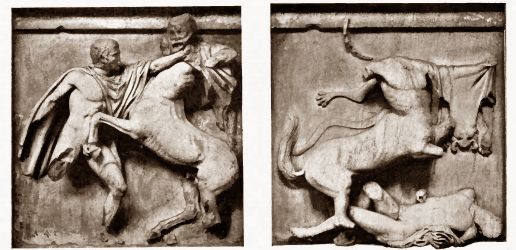 |
| Elgin Marbles - Metopes |
Elgin’s chaplain, Dr Phillip Hunt, immediately
despatched one of the carved metopes on board a ship bound for England and for
the next year an army of between three and four hundred men were employed
removing marble figures and inscriptions from the Acropolis.
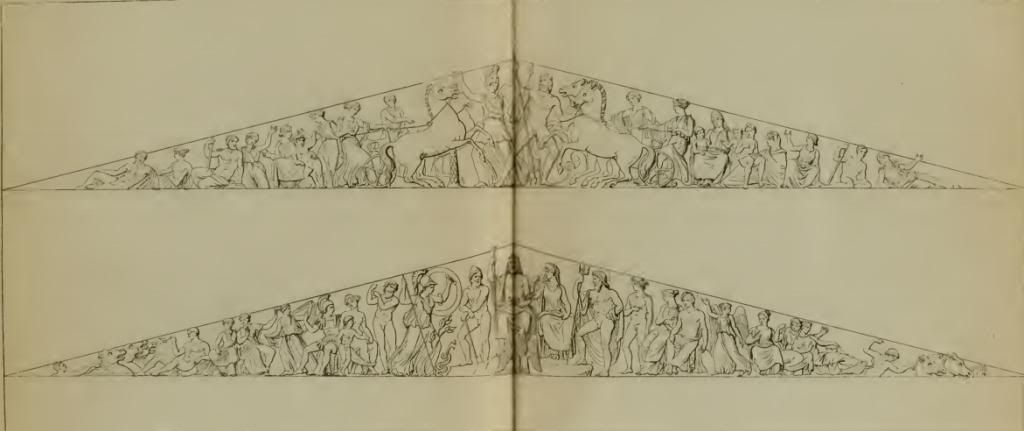 |
| The Parthenon Pediments - Stuart and Revett - 1745 |
Some of the
principal figures from the pediments, fifteen metopes and fifty-six slabs of
the frieze were removed from the Parthenon, together with numerous other loose
fragments; in addition, one of the caryatids was taken from the Erechtheion,
with four sections from the frieze of the temple of Athene Nike, a number of
architectural remains and more than a hundred inscribed stones making up
Elgin’s booty.
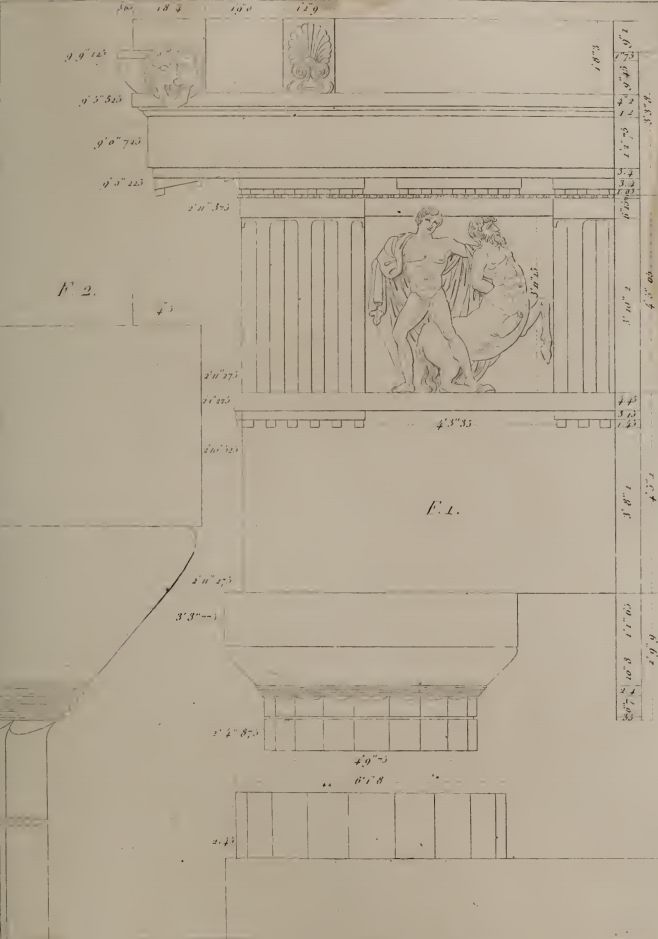 |
| Metope and Triglyph - Stuart and Revett - 1745 |
In 1803, he was recalled from his post and visited Athens on his
way home, where two hundred crates were ready for shipment. Elgin left Lusieri
to superintend matters and departed, but he was illegally detained by the
French and held in Paris for two years after a breakdown in the Peace of
Amiens. The brig Mentor sank off Cerigo, taking a dozen crates to the bottom
and it was only with great effort, and expense, that they were eventually
recovered.
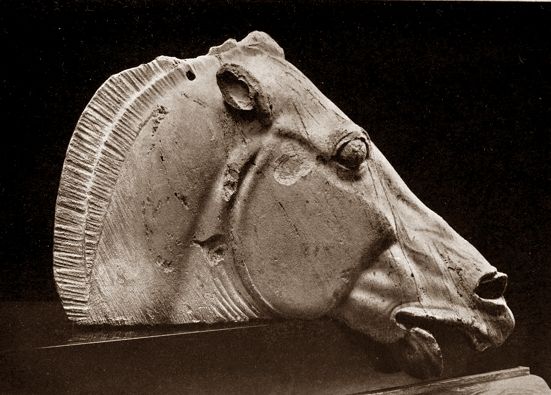 |
| Elgin Marbles - Horse of Selene |
It was not until 1812 that all of Lord Elgin’s marbles finally made
it to Britain, at a cost of over £70,000 but the British Museum refused to buy
them for such a large sum. In an attempt to recover his money, Elgin sued his
wife’s lover, Robert Ferguson, for an appropriately high amount and later
divorced her; she went on to marry Ferguson.
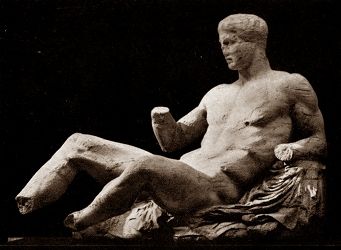 |
| Elgin Marbles - 'Theseus' - from east pediment |
In their first few years in
England, the crates were stored in the mansion of the Duchess of Portland, then
in Richmond Gardens, then at Elgin’s residence in Park Lane and finally at
Burlington House. Trouble then arrived from another quarter. Richard Payne
Knight, a classicist, collector and member of the Dilettanti Society, let it be
known that Jacob Spon, a traveller from some hundred and thirty years earlier,
had seen the statues on the pediment of the Parthenon and thought them to be
Roman additions from the second century.
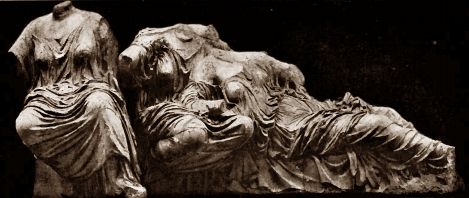 |
| Elgin marbles - The Fates - east pediment |
Without even seeing the marbles for
himself, Payne opined that Elgin had spent his time, money and effort on
inferior works from a later date, and they were not worthy of consideration. Such was Knight’s authority and standing,
Elgin found himself painted as an ignorant, tasteless vandal, as bad, if not
worse, than the souvenir keepsake-takers from whom he had sought to save the
statues.
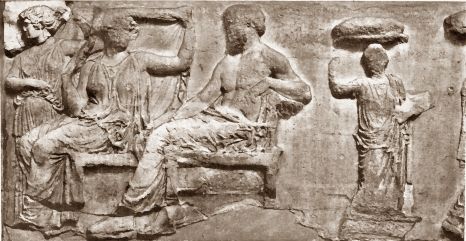 |
| Elgin Marbles - Hera and Zeus - east frieze |
He was nicknamed ‘Stone-monger’, ‘Marble-dealer’ and even
‘Marble-stealer’; Lord Byron weighed in with lines in his Childe Harold,
“The walls defaced, the mouldering shrines removed
By British hands, which it had best behoved
To guard those relics ne'er to be restored.”
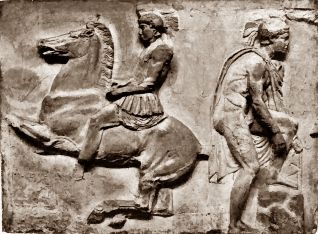 |
| Elgin Marbles - Preparing for Panathenaea - west frieze |
Things took a turn for the better for the 7th
Earl following the visit of two foreign connoisseurs; Ludwig, Crown Prince of
Bavaria, who examined the marbles and declared the reliefs to be the ‘perfection
of Art’, and Ennio Quirino Visconti, Director of the Musée Napoléon,
Paris, the greatest living archaeologist in the world, who asserted the
importance of the marbles to history and their significance to culture.
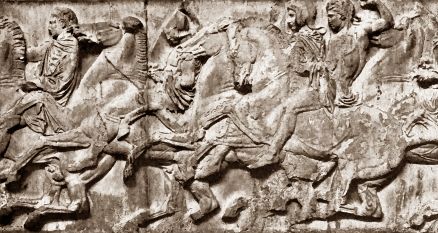 |
| Elgin Marbles - Horsemen - east frieze |
W R
Hamilton, Elgin’s former secretary and in 1815 the Under Secretary of State,
reissued a revised Memorandum on the subject of the Earl of Elgin’s Pursuits
in Greece, which recommended that Parliament purchase the marbles for the
nation.
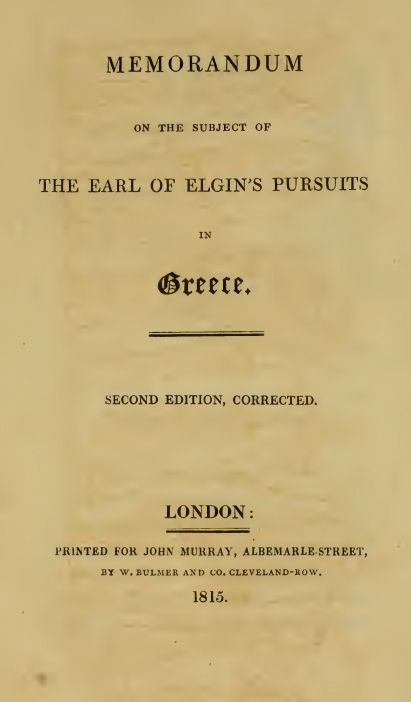 |
| W R Hamilton - Memorandum - 1815 |
Things were postponed, momentarily, by the Battle of Waterloo but after
Napoleon had been satisfactorily seen off and England was safe once more,
negotiations began again. After expert evidence was presented from, amongst
others, Benjamin West, President of the Royal Academy, and letters from foreign
experts read, Parliament decided on June 7th 1816, to pay Elgin
£35,000 for his marbles.
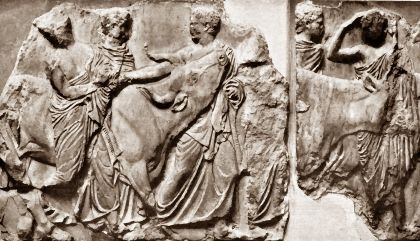 |
| Elgin Marbles - Preparing cattle for sacrifice - south frieze |
They were, and are, exhibited publicly in the British
Museum.
No comments:
Post a Comment